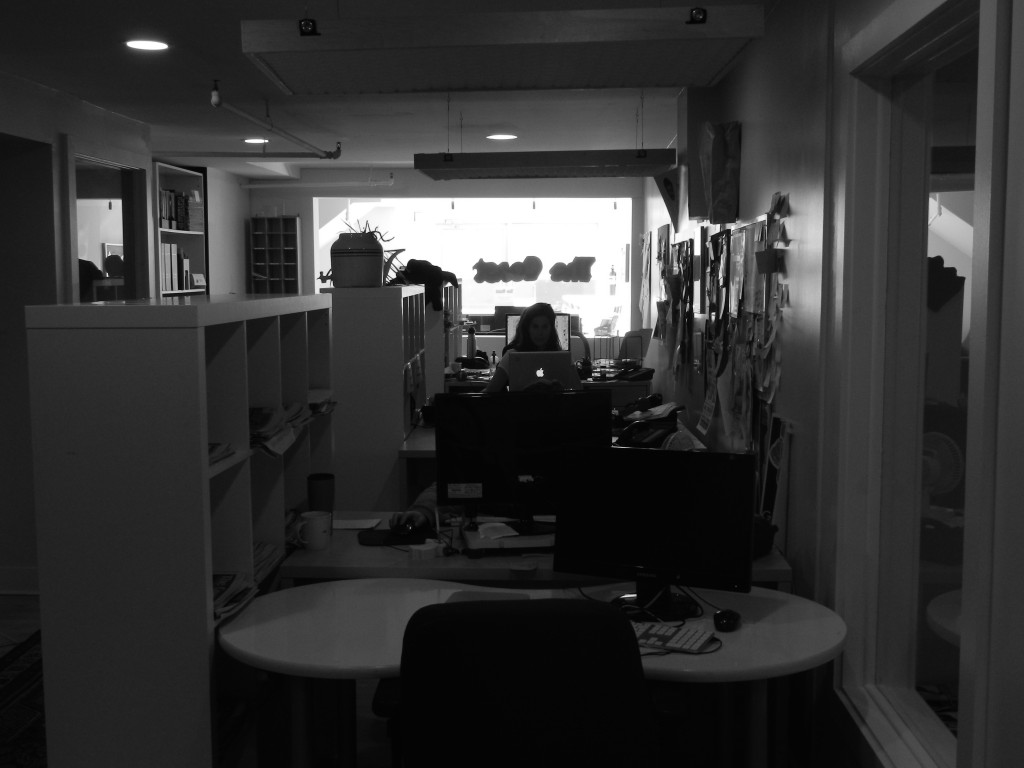Alt-weeklies fight for survival in digital age

caption
The inside of the Coast’s small office in Halifax.Small, locally-focused alt-weeklies have a better shot at staying alive
On September 13, 2013, there was a funeral in Boston. It wasn’t for a person: it was for an iconic, important, and freshly deceased alternative newsweekly. The Phoenix had fallen.
Leading a crowd of 25 mourners, four former Phoenix staffers carried a large, red, plastic newsbox from the corner of Massachusetts Ave and Newbury Street –– the site of the 1980s Phoenix offices –– about a kilometre to 126 Brookline Street, the paper’s last home.
Shaula Clark, former managing editor at the Phoenix, helped lug the newsbox. “Nobody thought about the logistics of it,” she said. “Like holy shit, the bottom (of the newsbox) is filled with sand.”
The procession, loud and boisterous, more resembled a pub crawl than a stuffy funeral.
During the twenty minute pilgrimage, two saxophone players riffed away in the back, an improv ode to the paper they – and the city of Boston – had loved.
“We were going for a New Orleans feel,” Clark said. “It was an unquiet funeral.”
The funeral was a symbolic end for the Phoenix after 47 years of publication. As Peter Vigneron wrote in a 2012 article for Boston magazine, “thirty years ago, the Phoenix was the essential paper for a new generation of readers: those interested in a smart, counter-cultural alternative to the offerings of the mainstream press.”
The Phoenix left behind a legacy of exceptional journalism. It served as a source of inspiration for young writers and helped launch the career of best-selling author Susan Orlean. Orlean’s books include The Orchid Thief and Rin Tin Tin, the Life and Legend.
Orlean worked at the Phoenix in the early ‘80s. She says the paper gave her a proper education. “That’s where I learned to write, to report, and to think of myself as a journalist; that’s where I grew up,” she wrote in a March 2013 article of the New Yorker.
“The people who came out for the Phoenix funeral were all over the place,” Clark said. “ It drove people out of the woodwork, people who had worked there a long long time ago. It brought together many different generations of the Phoenix.”
After the cortège arrived at Brookline Street – just around the bend from Fenway Park, home of the Boston Red Sox – the pallbearers dropped the open casket newsbox in the lobby of the empty office building.
The crowd then proceeded to the Arc, the venue for many Phoenix staff farewells. There they drank heavily to the paper’s memory well into the early fall night.
In a post on in the Facebook event page for the funeral, Carly Carioli, former-editor and chief of the Phoenix wrote, “I spent half my natural life at this newspaper, and I doubt I’ll love anything as much ever again.”
For Clark, the paper was “something between a cult and a family.”
“No sane person would do the amount of work required unless they really love it.”
Advertising stolen
October 2014 was a brutal, bloody month for alt-weeklies in America. Two alt-weeklies, both decades old, published their last issues in the same week.
The San Francisco Bay Guardian, owned by San Francisco Media Company, announced its last issue on Oct. 15. The Providence Phoenix, a sister publication of the Boston Phoenix, published its last issue on Oct. 17. The Guardian was 48 years old. The Providence Phoenix was 36 years old.
Glenn G. Zuehls, publisher of San Francisco Media Company, wrote in an email to employees that the paper was “not a viable business and (had) not been for many years.”
The death of the two weeklies is sad, but not surprising. According to the Pew Research Center, in 2011 alt-weekly circulation in the U.S fell by 14 per cent. In 2012, circulation dropped another 8 per cent.
“I don’t have a prescription for returning the alt-weeklies to health,” Reuters columnist and former San Francisco Weekly editor Jack Shafer said in an interview. “They basically had their audience and advertising base stolen from them.”
Traditionally, an alt-weeklie’s income was made up of single copy sales and revenue from advertising and the classified section. Crucial sections of papers – classifieds, for example – have dwindled.
“One of the places that papers made lots of money was classifieds,” Shafer said. “That market has been basically taken over by Craigslist.”
Papers are also growing thin. A high page count allows for more ad space, and more ad space means more revenue. In 2012 the Phoenix switched from a newsprint to a glossy, magazine style in an attempt to redefine itself and attract national ad revenue. The attempt failed. By the time it closed the Phoenix was losing a million dollars a year.
In a 2013 blogpost Shafer said, “The dead paper leaves behind $1.2 million in debt and roughly $500,000 in assets. The fact that its owner didn’t — or couldn’t — sell the publication to cover some of its debt signals the illness of the greater alternative weekly market.”
Tiffany Shackelford, the executive director of the Association of Alternative Newsmedia, in Washington D.C, says the loss of the classified section is old news. The statement that alt-weeklies are dying, she said, is an ill-informed generalization.
“I get so tired of the death of the alt-weekly mantra that we want to hear,” said Shackelford.
Coast publisher Christine Oreskovich on the key to the Coast‘s success in Halifax
The amount of attention alt-weeklies receive when they fold is disproportionate compared to the large-scale failures of other news organizations, Shackelford said.
“How many dailies can we name that have failed or cut back significantly? How many cuts are happening in CNN right now?” Shackelford asked.
“The death of the media? If it’s going to happen, it’s going to happen to all of us.”
Montreal is an alt-weekly ghost-town. In the late ‘90s, Montreal had four alt-weeklies: two English-speaking papers, the Mirror and the Hour, and two French papers, ici and Voir. Ici is the only survivor.
“It’s incredibly sad,” says Matthew Hays, a nationally published film critic and former associate editor of the Mirror.
A staple of any alt-weekly is the events section: a comprehensive directory of movies, concerts, art exhibits, and other cultural happenings. For artists, up-and-coming musicians and filmmakers, the events section gave them a way to be noticed and seen.

caption
Christine Oreskovich, publisher of the Coast, stands in the paper’s boardroom.When Hays wrote for the Mirror, he said, the print dailies in Montreal were dismissive of culture. “The dailies really had a tin ear – they were tone deaf to culture, particularly youth culture. The dailies really put culture at the back of the bus.”
The Mirror gave culture a voice.
Hays said the event sections was the pulse of the city. Visitors and locals alike would study the paper to know what was happening that week.
On June 21, 2012, the Montreal Mirror published its last issue. In a press release its owner, Quebecor — a chain described as a “media behemoth” by Lola Duffort of the McGill Daily — stated, “the growing popularity of digital media and communications has irremediably changed the context in which free cultural weeklies operate, bringing about economic challenges which have unfortunately compromised The Mirror‘s viability.”
“I’m still sad about it,” says Mark Slutsky, a former Mirror film critic. “I’m still sad about the way (Quebecor) did it. They had no understanding that (the paper) was part of the city’s culture.”
Hays said that the Mirror introduced him to the stress (and high payoff) of pumping out stories in the coffee-fueled, high-octane environment of a newsroom. Slutsky agreed, and said that during his time at the Mirror, Al Sutherland, his editor, taught him to write.
“We were writing for our readers, and he (Sutherland) didn’t like what he used to call bullshitty, masturbatory think pieces,“ Slutsky said. “He was really focused on making the newspaper readable and accessible, and not what he considered pretentious and ivory tower-ish.”
Hays and Sutherland both watched their alma mater fade into nothing.
“Now, there’s no Mirror here, and there’s no Hour,” Hays said. “It’s really diminished the opportunities for (journalists) who want to get their foot in the door.”
Not all doom and gloom
At the Coast’s office in Halifax, dogs have an unfettered reign over the newsroom. They wander from cubicle to cubicle in search of leftover lunch scraps and stomach scratches. About half the staff of 17 are dog owners.
Bean, a black Boston Terrier with a wishbone shaped streak of white stretching from the top of her head to her black, wet nose, often greets visitors with a friendly lick. Milly, an aging black Lab speckled with white hairs, basks in the sun by the front glass doors.
The Coast is independently owned by Christine Oreskovich and her husband, editor-in-chief Kyle Shaw. It’s the only alt-weekly in Halifax. “We’re an alternative voice in an alternative city,” Oreskovich says.
The Coast prints 23,000 copies a week, and claims to have a readership of about 76,000. The Coast proves it’s not all doom and gloom for the future of the alt-weekly.
The Coast, like other free alt-weeklies, makes the majority of its income through ads. Not all alt-weekly trends are locked in a downward spiral: local ad spending is on the rise.
“Local ad spending right now is high, and getting higher,” Shackelford said. “Local businesses have lasting relationships with )alt-weeklies).”
Healthy alt-weeklies tend to be smaller papers with an emphasis on the community they serve. Small alt-weeklies “know their worlds” according to Shackelford, and are able to adjust content and coverage to the needs of their community.
“When I read other media in the city, I don’t really see the city that I work, live, play and go out in,” said Oreskovich. The Coast aims to capture the true essence of what it means to be Haligonian. “A true alt-weekly cares and is cared about by its community.”
For Oreskovich, choosing between a daily and the Coast is like choosing a coffee place in the morning. “Like, do you go to Tim Hortons or do you go to Just Us!?”

caption
Millie, a Black Lab, lays out in the sun. Millie is obviously not a fan of conservatives.Evolution and creativity are essential ingredients in an alt-weekly’s success. Oreskovich said the loss of the classifieds section happened a decade ago, and the Coast has long since recovered from the blow. “Creating ways to monetize is in (an alt-weekly’s) blood,” Shackelford said.
The Coast is constantly catering to needs and whims of its readers. “We’re not just a newspaper,” said Oreskovich. “We have digital platforms. We have ticketing… We do production and layout services for other companies… We’ve created an ecosystem of communication to reach out to readers in different ways. (Readers) might pick up a paper, but they also might hit us on a mobile looking up a movie time.”
One of the most popular ways the Coast reaches out to readers and local businesses is through Best Of polls. Readers nominate, and vote, for their favorite businesses, restaurants, and people, and the results carry weight in the community.
Jennifer Sinclair is the owner of Down Home Dog, a pet grooming salon on Cunard Street. Sinclair won a gold medal for Best Dog Groomer in the Best of 2013 poll. In a town full of pups, Sinclair’s grooming was judged the best around.
“A lot of people call and make appointments because they Googled best dog groomer in Halifax,” Sinclair said.
It’s hard to picture Halifax without the Coast. But will Haligonians ever have to carry an empty newsbox in a funeral procession?
For now, alt-weekly readers in Halifax can rest easy. Oreskovich believes the Coast will remain an important news source for Haligonians.
“The Coast has to be true to Halifax, and the Halifax spirit,” she said. “We’re not a formula. We’re what works here in Halifax.”
The alt-weekly graveyard
Editor's Note
This story was reported and written by Oct. 17, 2014.

